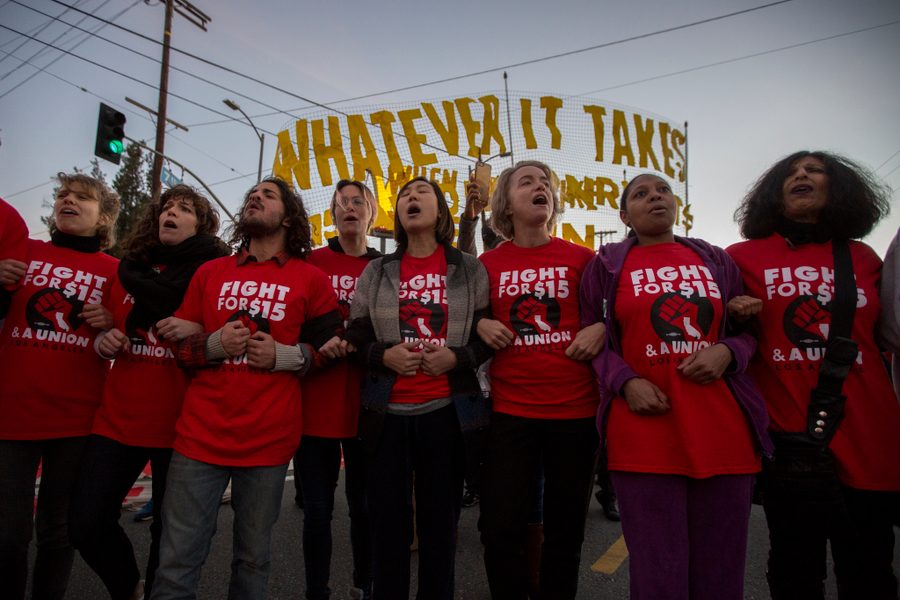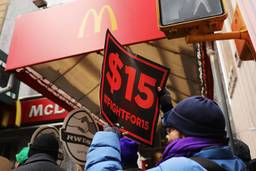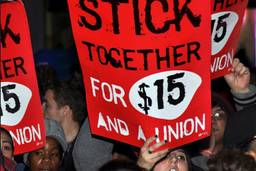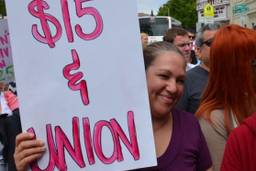
Shannon Johnson grew up with a birth defect in her throat that required multiple surgeries. Stuck in the hospital, she found solace in Disney movies. “I could get so immersed in the characters,” she said, recalling how she drew them on the walls of her bedroom. “It looked like a princess’ castle.”
Johnson, 40, now works in food service at Disneyland Resort, a set of hotels next to the theme park, in Anaheim, California. She said her hourly wage is $11, the state minimum. When she leads a shift, it’s $12, she said. Her hours vary significantly from one week to the next, as does her paycheck. She eats one meal per day, often consisting of a can of tuna and celery sticks.
She and her approximately 30,000 coworkers are asking for a raise, but not from Disneyland Resort. They’re counting on the residents of Anaheim. After contract negotiations with Disneyland Resort stalled, a coalition of unions submitted a city ballot measure this month that would require the resort and other large employers to pay an $18 minimum wage.
The campaign exemplifies an increasingly common model of labor advocacy: Rather than bargain directly with their employers, workers are pushing state and city governments to grant them benefits found in traditional union contracts, like wage increases and even dues payment. The teachers’ movements in West Virginia and Oklahoma are the latest examples of the strategy, which came to prominence nationwide with the Fight for $15. If the Supreme Court decides in favor of Janus, worsening a decades-long decline in union membership by rendering all public sector unions right-to-work, this strategy will become more popular, labor scholars and union officials say.
The strategy has delivered celebratory headlines and widespread worker gains for an ailing labor movement. But it remains an open and vital question whether the shift can meaningfully combat labor’s decline, as observers worry the model depends too much on elected officials and fails to restore or replace union power.
“People are now using the legislative process and the political process to get things that would normally have happened at the bargaining table,” Randi Weingarten, the president of the American Federation of Teachers (AFT), told In These Times.
Fight for $15, launched in 2012 with backing from the 2-million-member Service Employees International Union, began with two demands on behalf of fast food workers: $15 per hour base pay and a union. The wage demand quickly rose to the fore. Deploying high-profile single-day strikes, the campaign won minimum-wage hikes in cities and states across the country, including California and New York laws that will gradually raise each state’s hourly wage floor to $15.
Campaigners realized employers can undermine a wage increase with an hours cut. Their solution: local laws that require restaurants to offer additional hours to current workers before hiring new ones. A first-of-its-kind law passed in New York City last year, meanwhile, permits fast food workers to contribute a portion of each paycheck to a sector-specific advocacy group, mimicking union dues. The overall strategy assembles the components of a union contract with two parts missing: the union and the contract.
In West Virginia, striking teachers recently won a freeze on health insurance premiums for public employees and legislation that raised their pay by 5 percent. Lacking collective bargaining rights, the teachers found themselves in a similar position as nonunion fast food workers. Militant tactics bolstered public support, as they had for Fight for $15. “The strike made people aware of how bad things were,” said Jay O’Neal, a middle school teacher in Charleston, West Virginia. “When people found out, they were sympathetic.”
The Oklahoma Education Association, the top teachers’ union in the state, announced a statewide school closure set to begin on April 2, unless the Legislature passes a bill that raises pay and increases school funding. In Anaheim, workers at Disneyland Resort are gathering the 20,000 signatures necessary to put their wage hike on the ballot.
“The Fight for $15 broke the ice,” said Austin Lynch, an organizing director at UNITE HERE who has led the Anaheim ballot strategy. “Workers are being pushed to the edge. They’re going to stand up and find a way to do something about it.”
Lynch acknowledged the approach is “not where the union would like to be.” He said collective bargaining can serve a specific workplace better than a one-size-fits-all wage law. Weingarten, the AFT president, applauded legislative victories but spoke wistfully of trade unionism. “When we had more economic power at the bargaining table, people had more access to the middle class,” she said.
Nelson Lichtenstein, a professor of labor history at University of California, Santa Barbara, said legislative gains cannot replace union contracts. “How do you institutionalize the gains?” he wondered. “Conservatives have always been smart enough to say, ‘We’ll give in now, but in two years there won’t be an organization and it’ll be dead.’”
Legislation may fix that problem, too. Fast Food Justice, an advocacy group in New York City, has signed up well over 1,000 workers to contribute a portion of each paycheck to the organization. The city ordinance enabling the payments faces a legal challenge from the National Restaurant Association. If the law holds up, copycat groups in other cities and sectors may follow.
But the spread of labor-friendly laws depends on sympathetic city and state elected officials. As of last July, 25 states had passed laws forbidding cities from imposing wage hikes. Twenty-one states have yet to raise their wage floor above the federal minimum of $7.25. “There’s a limitation on the city strategy, and passing things at the state level adds another wrench to the plan,” said Stephanie Luce, a professor of labor studies at the City University of New York Graduate Center.
But Luce caught herself. “I don’t think anyone thought we would see this level of support for striking teachers in West Virginia,” she said. “We may be looking back at this moment in 30 years and saying this is when things changed. Whether for better or worse, remains to be seen.”







